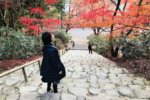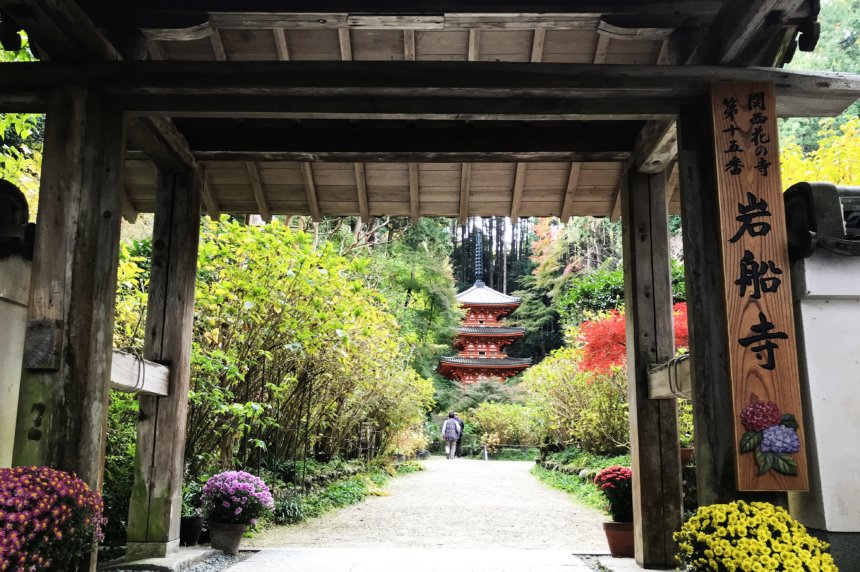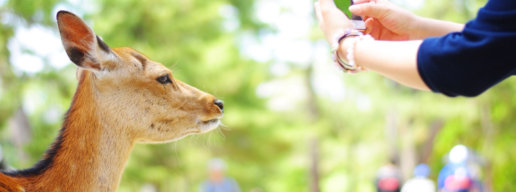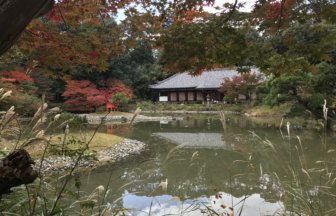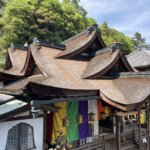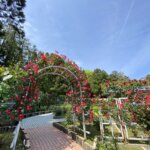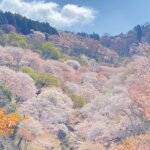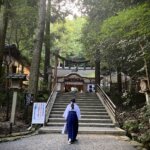Like Joruri-ji Temple, Gansen-ji is located in Kyoto Prefecture, almost on the border with Nara. This area was under the strong influence of Buddhism, that flourished in Nara when it was the capital of Japan.
The history of the temple is said to date back to 729, when Emperor Shomu (701-756) ordered Gyoki, a Buddhist priest who promoted Buddhism in Japan but was persecuted by the Imperial Court at that time, to build the temple.
This small charming temple, known as the “temple of flowers,” is nestled in the thickly forested mountains. It is beautiful in all seasons but especially famous for its hydrangeas in early summer and red leaves in autumn.
http://gansenji.or.jp/g-spring.html
(Pictures on the official site representing four seasons)
Structures
Three-Story Pagoda
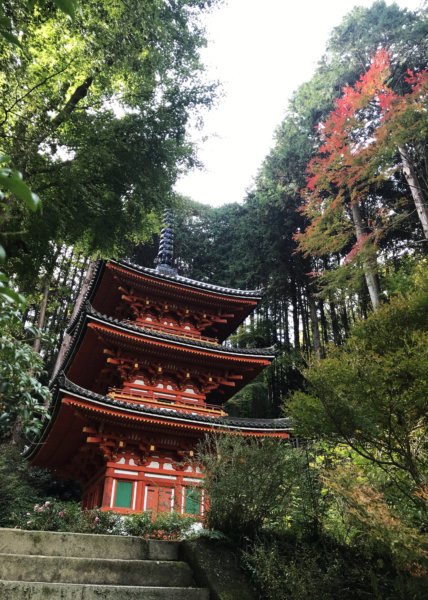
The vermilion pagoda stands on the hillside behind the pond, surrounded by trees like a picture frame that enhances the beauty of the artwork. Originally built around 834 to 847 by Emperor Nimyo, the existing 18-meter-high pagoda is thought to have been built during the Muromachi period (1336-1573). The interior of the building, with its gorgeously-colored walls and doors, is open to the public only on weekends in October and November.
Thirteen-Story Stone Pagoda
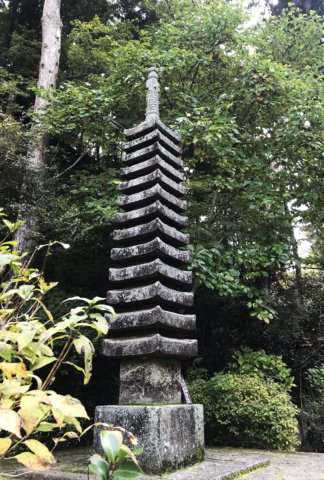
The 5.5-meter-high pagoda is said to have been erected in 1314 by a high priest named Myoku. The roof size is constantly reduced from bottom to top, giving a linear and organized impression. Both pagodas are Important Cultural Properties.
Buddha Statues in the Main Hall
Seated Amida Nyorai
This 3-meter-high seated figure was carved from a single zelkova tree presumably in 946. Its round face, gentle expression and thick body are typical of Buddhist images from the mid-10th century. It is characterized by the red robe and you can see the remaining color if you look up-close. The halo consists of two simple circles.
Four Heavenly Kings
The four kings surround Amida Nyorai on the platform in the Main Hall. Although built in 1293, these statues with clearly defined facial features give an almost modern impression.
Fugen Bosatsu Riding an Elephant
The Bosatsu on a white elephant is in a small shrine at the back of the hall. This feminine and graceful little statue was made in the Heian period (794-1185). As the elephant has as many as six tusks and yet seems to be smiling, you might be confused if it is ferocious or peaceful! The interior of the shrine is decorated with mandalas in rich colors.
Amida Nyorai and Fugen Bosatsu are Important Cultural Properties.
Twelve Heavenly Generals
The Generals are lined up at the back of the Main Hall. With large heads and childlike proportions, they have cuteness like manga characters. It is rare that each General has an animal on its head that indicates the year it guards. For more information about the relationship between the Twelve Heavenly Generals and the twelve signs of the Oriental Zodiac, please read the explanation of Shin Yakushi-ji Temple.
Visit the official Gansen-ji website to look at the pictures of the statues.
http://gansenji.or.jp/#a_about
Special Exhibition of the Hidden Kannon Bosatsu Statue and Other Two Statues:
From January 1 to 15, from April 1 to May 31 and from October 1 to November 30
Special Opening of the Three-Story Pagoda:
On Saturdays, Sundays and Holidays in October and November
* Please note that the opening may be suspended due to rain and wild weather without prior notice.
Information:
Hours:
8:30 to 17:00 (March to November)
9:00 to 16:00 (December to February)
* Enter 15 minutes earlier than the closing time.
Admission:
Adult: 500 yen
Address:
Kaminomon 43, Iwafune, Kamo-cho, Kizugawa City, Kyoto 619-1133 Japan
* You are always asked to check information on the official website before you visit.
http://gansenji.or.jp/access.html
(No English translation available)
Access:
– Take The Kizugawa City Community Bus at JR Kamo Station to Gansen-ji for about 15 minutes, and another 6 minutes to Joruri-ji Temple. They have 8 round trip services a day. Timetable(only in Japanese) 20191226-114443.pdf (kizugawa.lg.jp)
One way ticket from JR Kamo Station is 300 yen to Gansen-ji and 400 yen to Joruri-ji. 200 yen between Gansen-ji and Joruri-ji. * as of May 2021 JR Kamo Station is about 70 minutes from JR Osaka station on the Yamatoji Line by a direct rapid train via JR Nara Station. From JR Nara Station it is about 14 minutes.
– There is another way from Nara. The Nara Kotsu Bus has seasonal bus services between JR Nara Station and Gansen-ji/Joruri-ji Temples via Kintetsu Nara Station. The service is available on Sat, Sun and National Holidays in April, May and Nov, and Oct 31 * as of May 2021 Please make sure to check the Nara Kotsu bus timetable when you plan to go. https://www.narakotsu.co.jp/news/news_1148.html (Japanese only)
You can also enjoy 40-to-50-mins “Stone Buddha Walk” between Gansen-ji and Joruri-ji Temples. For detailed access information to both temples and “Stone Buddha Walk” route map, see the Recommended Route page (to be uploaded later).
Last updated: May 13, 2021
Text by: Yumi